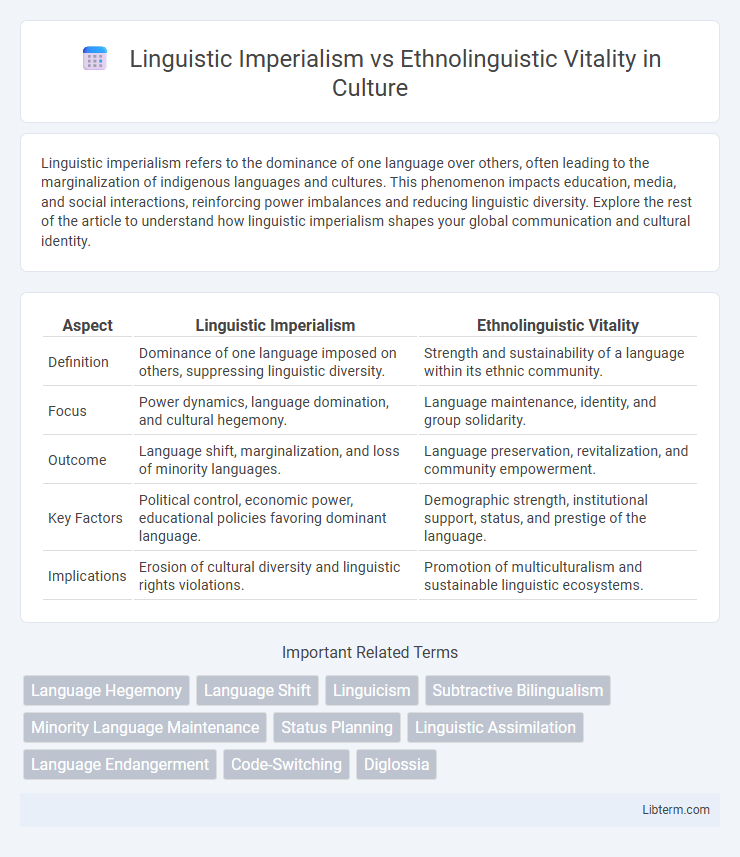Linguistic imperialism refers to the dominance of one language over others, often leading to the marginalization of indigenous languages and cultures. This phenomenon impacts education, media, and social interactions, reinforcing power imbalances and reducing linguistic diversity. Explore the rest of the article to understand how linguistic imperialism shapes your global communication and cultural identity.
Table of Comparison
| Aspect | Linguistic Imperialism | Ethnolinguistic Vitality |
|---|---|---|
| Definition | Dominance of one language imposed on others, suppressing linguistic diversity. | Strength and sustainability of a language within its ethnic community. |
| Focus | Power dynamics, language domination, and cultural hegemony. | Language maintenance, identity, and group solidarity. |
| Outcome | Language shift, marginalization, and loss of minority languages. | Language preservation, revitalization, and community empowerment. |
| Key Factors | Political control, economic power, educational policies favoring dominant language. | Demographic strength, institutional support, status, and prestige of the language. |
| Implications | Erosion of cultural diversity and linguistic rights violations. | Promotion of multiculturalism and sustainable linguistic ecosystems. |
Introduction to Linguistic Imperialism
Linguistic imperialism refers to the dominance of one language over others, often imposed through political, economic, or cultural power, leading to the marginalization or extinction of minority languages. This concept highlights the power dynamics involved in language spread, where dominant languages such as English operate as tools of cultural and ideological control. Understanding linguistic imperialism is crucial for analyzing the threats to ethnolinguistic vitality, which measures the sustainability and strength of minority language communities.
Defining Ethnolinguistic Vitality
Ethnolinguistic vitality refers to the perceived strength and sustainability of a language within a specific community, measured by factors such as demographic presence, institutional support, and status prestige. It determines a group's ability to maintain and assert its language against dominant forces often exemplified by linguistic imperialism. High ethnic vitality correlates with greater language maintenance and resistance to assimilation pressures, preserving cultural identity through language use.
Historical Contexts of Linguistic Imperialism
Linguistic imperialism originated during European colonial expansion, where dominant languages like English, Spanish, and French were imposed on colonized populations, marginalizing indigenous languages and cultures. This historical process has led to the erosion of ethnolinguistic vitality, which refers to a community's ability to maintain and promote its language and cultural identity. The lasting impacts include language shift, loss of linguistic diversity, and socio-political inequalities linked to language dominance.
Key Indicators of Ethnolinguistic Vitality
Key indicators of ethnolinguistic vitality include status, demographic strength, and institutional support, which determine a language community's ability to maintain and develop its language and culture. Status entails the perceived prestige and economic value of the language, while demographic strength refers to the size and concentration of its speakers. Institutional support encompasses the presence of the language in education, media, government, and other formal domains, countering the effects of linguistic imperialism by promoting linguistic diversity and resilience.
Mechanisms of Language Dominance and Marginalization
Linguistic imperialism operates through mechanisms such as institutional dominance, media control, and educational policies that prioritize a dominant language, leading to the marginalization of minority languages. Ethnolinguistic vitality, influenced by factors like demographic strength, institutional support, and status, determines a language community's ability to maintain and promote its language amid external pressures. The interplay between these forces shapes the survival or decline of languages, with dominance often resulting in reduced linguistic diversity and weakened cultural identity.
The Impact of Linguistic Imperialism on Minority Languages
Linguistic imperialism significantly undermines minority languages by imposing dominant languages through education, media, and government, leading to language shift and loss of cultural identity. Ethnolinguistic vitality, reflecting a community's ability to maintain and promote its language, diminishes as resources and prestige favor dominant languages. This imbalance threatens linguistic diversity and erodes minority language use across generations.
Strategies for Strengthening Ethnolinguistic Vitality
Strengthening ethnolinguistic vitality involves promoting language maintenance through community-driven education programs and media representation to enhance intergenerational transmission. Strategic policies supporting minority language use in public domains and official recognition counteract linguistic imperialism's dominance by validating linguistic diversity. Empowering local speakers with language rights and resources fosters resilience against language shift and cultural assimilation pressures.
Case Studies: Linguistic Imperialism vs. Ethnolinguistic Vitality
Case studies examining linguistic imperialism reveal how dominant languages, such as English in former colonies, suppress indigenous languages, leading to cultural erosion and loss of linguistic diversity. In contrast, ethnolinguistic vitality research highlights communities like the Basques and Maori, where strong language policies and community efforts sustain language use and cultural identity despite external pressures. These comparative analyses demonstrate that while linguistic imperialism often diminishes minority languages, robust ethnolinguistic vitality can counteract this effect through institutional support and active language transmission.
Policy Implications and Language Rights
Linguistic imperialism often leads to dominant languages overshadowing minority languages, necessitating policies that protect language diversity and promote equitable language rights. Ethnolinguistic vitality highlights the importance of community support, institutional recognition, and cultural resources in sustaining minority languages, shaping language policy to reinforce these factors. Effective language policies must balance power dynamics and empower linguistic minorities through legal recognition, education rights, and media representation.
Future Directions in Balancing Linguistic Power
Future directions in balancing linguistic power emphasize the promotion of ethnolinguistic vitality through supportive language policies that protect minority languages from the dominance of linguistic imperialism. Technological advancements, such as AI-driven language preservation tools and digital inclusion strategies, offer new pathways to empower marginalized language communities and foster multilingual environments. Collaborative efforts between governments, local communities, and global organizations are essential to create equitable linguistic landscapes and sustain diverse linguistic identities.
Linguistic Imperialism Infographic

 libterm.com
libterm.com